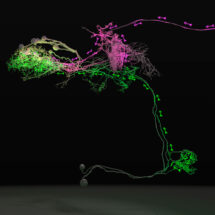
As well as having instinctive responses to their environment, nearly all animals can learn to associate particular sights, smells, or sounds with rewards or negative consequences. It had been thought that two separate brain centres control these two different types of responses; innate and learned. However, researchers from Greg Jefferis’ group in the LMB’s Neurobiology Division have shown for the first time a brain circuit in which learned and innate responses converge, at the resolution of connections between individual neurons.
Learned responses require memory storage and retrieval. Although we know much about how memory is stored in the brain, we know less about how memories are retrieved or how these retrieved memories interact with the neurons that direct instinctive, or innate, behaviours. To answer this question, Mike Dolan and Alexander Bates from Greg’s group and collaborators at ESPCI Paris led by Pierre-Yves Plaçais, used the vinegar fly, Drosophila melanogaster, due to its numerically simple brain of only about 100 thousand neurons (the human brain has approximately 100 billion).
Initially, the researchers identified a type of neuron in the fly brain that seemed to be perfectly placed to receive input from both channels responsible for instinctive responses to smells and a memory readout neuron. They then trained the flies to associate a particular smell with a small electric shock, so that the flies would learn to avoid that smell, retrieving this negative memory even when the shock is not given. They found that if they de-activated their neuron-type of interest, flies were less able to recall the negative memory and less likely to avoid the smell in future. Importantly, these de-activated neurons were in the region of the brain thought to be responsible for instinctive behaviours and their deactivation also made the flies less attracted to food odours.
Greg’s team was able to map the connections in the neural circuit that controls this effect. Together the teams showed that recalling a negative memory reduces signalling through the pathway that mediates instinctive responses to attractive odours. It seems that remembering something bad makes the fly think that it is currently smelling less of something nice. This shows that the classical division of the brain into areas for innate behaviour and learned responses may be too simple. The team have also shown exactly where in the brain and how the cross-talk between these brain centres occurs.
Fly brains are a useful model system both because they can be studied with many sophisticated experimental tools and because of their relative simplicity. Greg’s group is actively contributing to a map of all of the neuronal connections in the fly brain, or connectome, currently in development with collaborators at Janelia Research Campus in the USA. The sense of smell in flies follows many of the same rules as those in the mammalian brain, so it is possible that these findings in the fly might translate to a greater understanding of the human brain. A greater understanding of memory could one day impact the development of treatments for people suffering with traumatic memories or memory loss due to ageing.
The work was funded by the MRC, the European Research Council, the Wellcome Trust, Agence Nationale de la Recherche, Boehringer Ingelheim Fonds, and the Howard Hughes Medical Institute.
Further references:
Paper in Neuron
Video abstract for paper
Greg Jefferis’ group page
Pierre-Yves Plaçais’ and Thomas Preat’s group page
Janelia Research Campus page